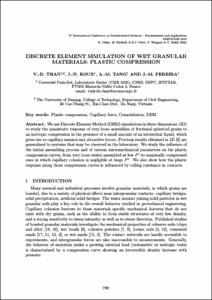Mostra el registre d'ítem simple
Discrete element simulation of wet granular materials: plastic compression
| dc.contributor.author | Than, V.-D. |
| dc.contributor.author | Roux, J-N. |
| dc.contributor.author | Tang, A.-M. |
| dc.contributor.author | Pereira, J.-M. |
| dc.date.accessioned | 2020-05-19T10:53:53Z |
| dc.date.available | 2020-05-19T10:53:53Z |
| dc.date.issued | 2015 |
| dc.identifier.isbn | 978-84-944244-7-2 |
| dc.identifier.isbn | Anglès |
| dc.identifier.uri | http://hdl.handle.net/2117/188077 |
| dc.description.abstract | We use Discrete Element Method (DEM) simulations in three dimensions (3D) to study the quasistatic response of very loose assemblies of frictional spherical grains to an isotropic compression in the presence of a small amount of an interstitial liquid, which gives rise to capillary menisci and attractive forces. Previous results obtained in 2D [8] are generalized to systems that may be observed in the laboratory. We study the influence of the initial assembling process and of various micromechanical parameters on the plastic compression curves, from very loose states assembled at low P∗ to maximally compressed ones in which capillary cohesion is negligible at large P∗. We also show how the plastic response along those compression curves is influenced by rolling resistance in contacts. |
| dc.format.extent | 12 p. |
| dc.language.iso | eng |
| dc.publisher | CIMNE |
| dc.subject.lcsh | Finite element method |
| dc.subject.lcsh | Computational methods in mechanics |
| dc.subject.lcsh | Particle methods (Numerical analysis) |
| dc.subject.other | Plastic compression, Capillary force, Consolidation, DEM |
| dc.title | Discrete element simulation of wet granular materials: plastic compression |
| dc.type | Conference report |
| dc.subject.lemac | Elements finits, Mètode dels |
| dc.rights.access | Open Access |
| local.citation.contributor | PARTICLES IV |
| local.citation.publicationName | PARTICLES IV : proceedings of the IV International Conference on Particle-Based Methods : fundamentals and applications |
| local.citation.startingPage | 789 |
| local.citation.endingPage | 800 |


